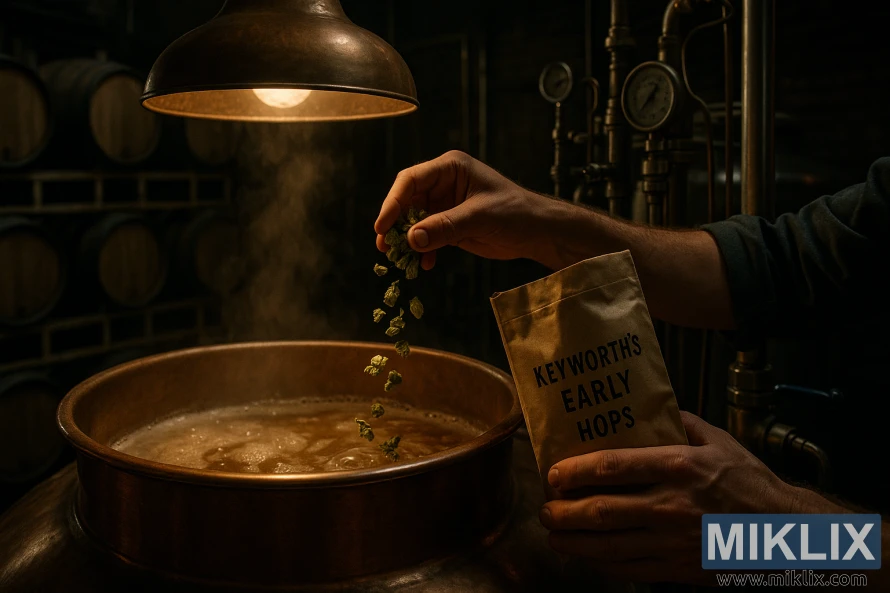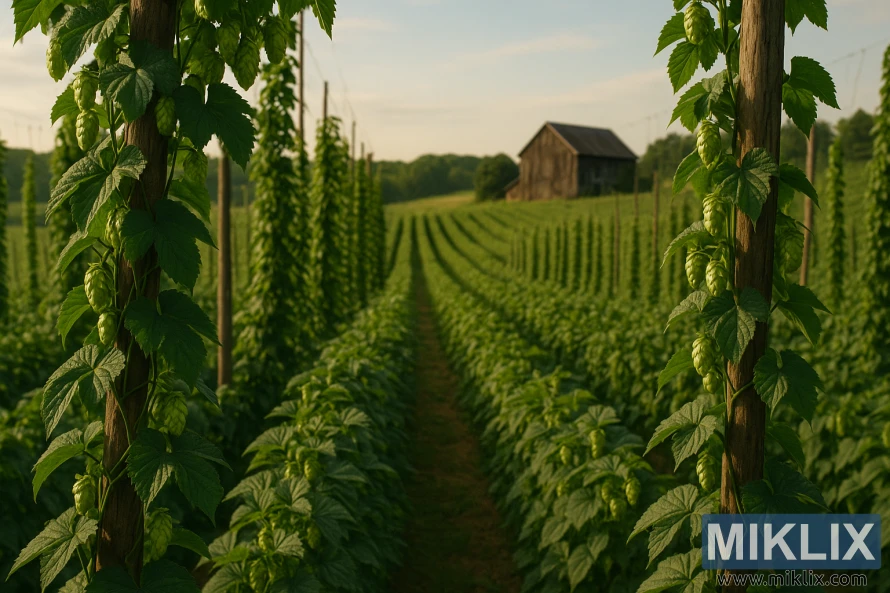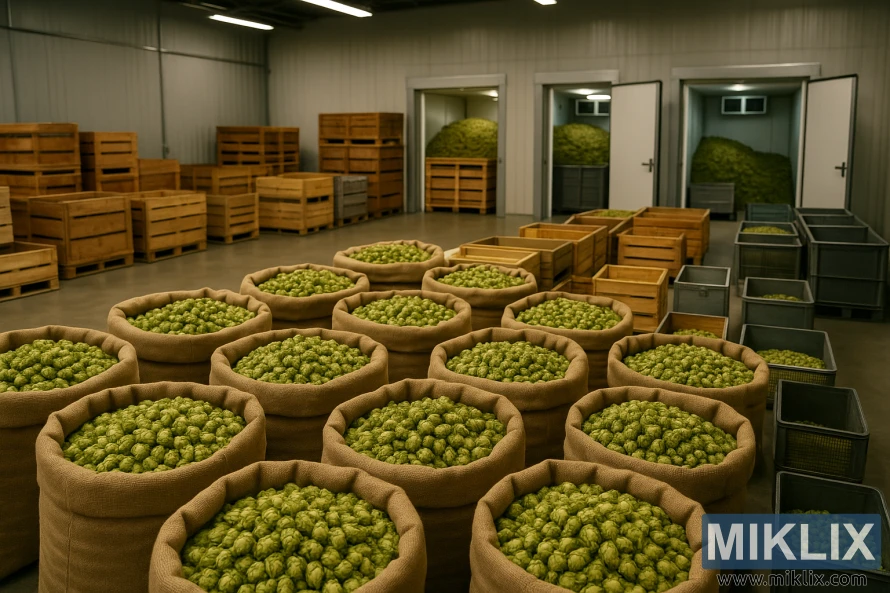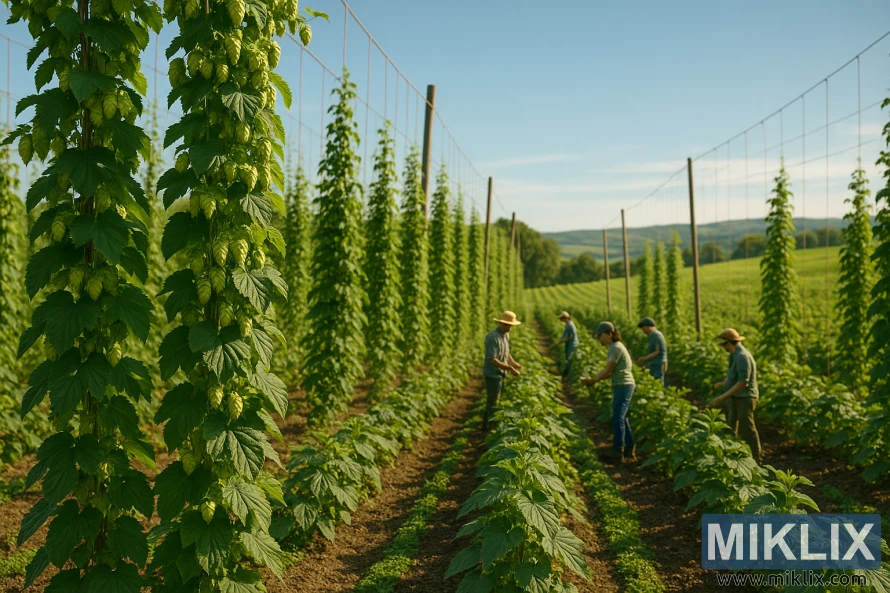Hops in Beer Brewing: Keyworth's Early
Published: July 24, 2025 at 7:41:56 AM UTC
Beer brewing is an art that demands precision, creativity, and the perfect ingredients. The selection of hop varieties is key to crafting unique beers. Keyworth's Early Hops, with their distinct flavor, are a versatile choice for brewers. By using Keyworth's Early Hops, brewers can create a wide array of beer styles. From crisp lagers to complex ales, these hops offer a unique edge. They are perfect for brewers eager to explore new flavors.

Key Takeaways
- Keyworth's Early Hops offer a distinct flavor profile for beer brewing.
- These hops are versatile and can be used in various brewing techniques.
- Brewing with Keyworth's Early Hops allows for the creation of diverse beer styles.
- The unique characteristics of these hops make them ideal for experimentation.
- Using Keyworth's Early Hops can elevate the quality of your beer.
The History of Keyworth's Early Hops
The East Malling Research Station was instrumental in the 1940s. They developed Keyworth's Early Hops, a variety that became vital to the brewing world. This era was marked by significant advancements in hop breeding and cultivation techniques.
Keyworth's Early Hops were bred to improve their brewing qualities. The breeding process involved meticulous selection and cross-breeding. The goal was to achieve traits like disease resistance and high yield.
The East Malling Research Station's work in the 1940s was a response to the brewing industry's need for quality hops. Their efforts in that decade set the stage for future breakthroughs in hop breeding.
Today, Keyworth's Early Hops are recognized in hop history. They have played a key role in the development of various beer styles. Their influence on the brewing industry highlights the ongoing need for innovation in hop cultivation.
Understanding Keyworth's Early Hops Characteristics
Keyworth's Early Hops stand out with their unique flavor profile, a key factor in their popularity among brewers. Their distinct traits make them a favorite among those aiming to add a unique twist to their beers.
The flavor profile of Keyworth's Early Hops is marked by pungent grapefruit and lemon notes. These citrus flavors stem from the specific chemical compounds in the hops. They contribute to the hops' distinctive aroma and flavor.
The aroma of Keyworth's Early Hops is equally noteworthy, boasting a pronounced citrus scent. This citrus aroma significantly enhances the beer's overall sensory experience. In brewing, the aroma plays a critical role in shaping the beer's character.
- The unique flavor profile of Keyworth's Early Hops makes them suitable for a variety of beer styles.
- Their aroma characteristics complement a range of brewing ingredients, enriching the beer's complexity.
- Breweries value the consistency and quality of Keyworth's Early Hops, making them a dependable choice for craft brewing.
In summary, Keyworth's Early Hops provide a compelling mix of flavor and aroma that can enhance beer quality. Understanding their characteristics is vital for brewers aiming to use these hops effectively in their brewing endeavors.
Growing Conditions and Requirements
Keyworth's Early Hops need specific growing conditions to thrive. They require rich soil and a temperate climate. The soil, temperature, and humidity requirements are key for their optimal cultivation.
These hops need rich, well-drained soils to grow well. The soil should have a balanced nutrient mix and good drainage. This prevents waterlogged conditions.
The climate is also critical for growing Keyworth's Early Hops. They do best in a temperate climate with moderate temperatures and enough moisture. They need a certain humidity level, mainly in their early growth stages.
- Rich, well-drained soils are essential for healthy root development.
- A temperate climate with moderate temperatures supports vigorous growth.
- Adequate humidity, mainly in the early stages, is critical.
Understanding these conditions is vital for brewers and farmers growing Keyworth's Early Hops. By meeting these specific needs, they can produce a high-quality yield. This meets the high standards of craft brewing.

Chemical Composition and Aromatic Profile
The alpha acid content and oil profile of Keyworth's Early Hops are key factors in their flavor and aroma. With an alpha acid content ranging from 6.1% to 7.9%, these hops offer a balanced bitterness. This is essential for various beer styles.
Keyworth's Early Hops are characterized by their alpha acid content, which contributes to the bitterness in beer. The oil profile, including myrcene, humulene, and other compounds, influences the aroma and flavor. Understanding the hop chemistry is critical for brewers to achieve the desired taste and aroma in their beers.
- The alpha acid content of Keyworth's Early Hops provides a smooth bitterness.
- The oil profile contributes to the complex flavor and aroma.
- The combination of these chemical properties makes Keyworth's Early Hops versatile for brewing.
The aromatic profile of Keyworth's Early Hops is influenced by their chemical composition. The presence of various oils and other compounds results in a complex and balanced aroma. This enhances the overall character of the beer. Brewers can leverage this profile to create a wide range of beer styles.
Harvesting and Processing Methods
The process of harvesting and processing Keyworth's Early Hops is vital. It greatly influences their quality and flavor. These hops are picked in late summer, when their cones are fully ripe and their aroma is at its strongest.
The timing of the harvest is key. It affects the hops' bitterness, flavor, and aroma. Farmers watch the hops closely to find the perfect time to pick. After picking, the hops are dried to lower their moisture and keep their quality.
Drying methods differ, but oast houses and specialized facilities are common. These places have systems to control temperature and airflow. This gentle drying helps preserve the hops' delicate cones.
- Careful handling to prevent damage to the hop cones
- Controlled drying conditions to preserve flavor and aroma
- Monitoring of moisture content to ensure optimal drying
After drying, the hops are turned into various products. These include whole hops, pellets, or extracts. These products are then used in brewing. The detailed harvesting and processing of Keyworth's Early Hops ensure brewers get top-notch ingredients for their beers.
Brewing Applications of Keyworth's Early Hops
Keyworth's Early Hops are gaining popularity in brewing due to their distinct traits. They are ideal for a variety of beer styles, such as pale ales and IPAs. This is because of their balanced alpha acid content and unique aromatic profile.
These hops provide brewers with the flexibility to craft complex beers. Their moderate bitterness and floral, spicy flavors are perfect for hop-forward beers. They can be used at different stages of brewing, from bittering to adding flavor and aroma, to enhance the beer's character.
The versatility of Keyworth's Early Hops is a major advantage. They are suitable for:
- Pale ales, where their citrus and floral notes complement the malt profile.
- IPAs, where their bitterness and flavor contribute to the beer's overall hop character.
- Other hop-forward beers, such as Double IPAs and pale lagers, where their unique characteristics can enhance the beer's complexity.
By using Keyworth's Early Hops in their recipes, brewers can create a range of beer styles. These beers showcase the hops' unique attributes. Whether for bittering, flavor, or aroma, Keyworth's Early Hops are a valuable addition to any brewery's hop inventory.
Beer Styles Best Suited for Keyworth's Early
For brewers aiming to craft hop-forward beers, Keyworth's Early is a prime selection. This hop variety excels in American-style ales, where its distinct traits can truly come to life.
Keyworth's Early Hops are ideal for pale ales, providing a harmonious mix of bitterness and flavor. Their aromatic profile beautifully complements the crisp, refreshing essence of pale ales. This makes them a favorite among brewers.
IPAs also greatly benefit from Keyworth's Early Hops. The variety's robust flavor and aroma enhance the hoppy essence of IPAs. This results in a complex and engaging drinking experience.
Some of the key beer styles that benefit from Keyworth's Early Hops include:
- American-style ales
- Pale ales
- IPAs
- Other hop-forward beers
By integrating Keyworth's Early Hops into their brews, craft brewers can craft a wide array of delicious and complex beer styles. These showcase the unique qualities of this versatile hop variety.
Comparing Keyworth's Early to Other Hop Varieties
Keyworth's Early Hops stand out among hop varieties, bringing unique traits to brewers. They differ from others in flavor profile, aroma, and brewing uses. This makes them a valuable addition to the brewing world.
Their flavor is often described as earthy and herbal. This contrasts with Cascade and Chinook, which have citrus and pine notes. This distinction makes Keyworth's Early Hops ideal for beers needing a subtle hop flavor.
Keyworth's Early Hops are versatile, fitting into a range of beer styles. They're perfect for balanced hop flavors in pale ales and bitters. In contrast, Saaz and Hallertau are favored for traditional European beers like pilsners and lagers.
- Keyworth's Early Hops offer a unique earthy and herbal flavor profile.
- Other hop varieties, such as Cascade and Chinook, have distinct citrus and pine notes.
- Keyworth's Early Hops are versatile and suitable for various beer styles.
When comparing Keyworth's Early Hops to others, brewers must consider each variety's unique characteristics. This knowledge helps them choose the right hops for their beers. Understanding these differences is key to creating the perfect brew.
Best Practices for Storage and Handling
Preserving the quality of Keyworth's Early Hops demands attention to storage and handling methods. Proper storage is essential to maintain the hops' flavor and aroma.
For effective storage, brewers should place hops in a cool, dry spot, away from sunlight and heat. The best conditions include low temperatures and minimal oxygen exposure.
- Handle hops gently to minimize damage and preserve their natural oils.
- Use airtight containers to store hops, reducing exposure to air.
- Keep hops away from strong-smelling substances, as they can absorb odors easily.
By adhering to these storage and handling guidelines, brewers can ensure Keyworth's Early Hops remain in top condition. This ensures they contribute to the creation of exceptional beers.

Common Brewing Techniques with Keyworth's Early
Keyworth's Early Hops are celebrated for their adaptability in brewing, enriching beer's taste. Their versatility and distinct qualities make them a favorite among brewers. They enhance various beer styles, adding depth and complexity.
These hops excel in dry hopping and whirlpool hopping. Dry hopping adds flavors and aromas post-fermentation, without bitterness. Whirlpool hopping, done after the boil, extracts hop flavors and aromas.
Some common brewing techniques that utilize Keyworth's Early Hops include:
- Dry hopping to enhance aroma and flavor
- Whirlpool hopping for added depth of flavor
- Early boil additions for bitterness and flavor
When brewing with Keyworth's Early Hops, timing and method are key. Experimenting with different techniques can help brewers find the best way to use these hops. This ensures the desired flavor and aroma in their beers.
By integrating Keyworth's Early Hops into their brewing, brewers can craft a variety of beers. These beers boast complex and nuanced flavor profiles, pleasing even the most discerning palates.
Troubleshooting Common Issues
Brewers aiming for the perfect hop flavor and aroma in their beers must tackle common problems with Keyworth's Early Hops. These hops can face flavor and aroma challenges if not stored or handled correctly.
Keyworth's Early Hops require careful handling to preserve their delicate flavor and aroma. Brewers can address common issues by:
- Ensuring hops are stored in a cool, dry place.
- Confirming proper processing and handling to avoid damage.
- Monitoring brewing techniques for optimal hop addition timing and quantity.
Understanding and addressing common issues with Keyworth's Early Hops is key. Brewers must be attentive to the hops' characteristics, growing conditions, and processing methods. This ensures the hops' optimal flavor and aroma in the beer.
Effective troubleshooting also means being aware of brewing pitfalls with Keyworth's Early Hops. This includes avoiding over- or under-dosing. By mitigating these risks, brewers can highlight the unique qualities of these hops in their beers.
Recipe Development Guidelines
Keyworth's Early Hops provide brewers with a versatile ingredient for unique beer recipes. Their distinct characteristics make them suitable for a wide range of brewing applications.
When developing recipes with Keyworth's Early Hops, brewers should consider several key factors. First, they must understand the hop's chemical composition and aromatic profile. This knowledge will help brewers to balance the flavors and aromas in their beer.
To get the most out of Keyworth's Early Hops, brewers can experiment with different brewing techniques. For example, they can use the hops for bittering, flavor, or aroma additions, depending on the desired outcome.
Some tips for using Keyworth's Early Hops in recipe development include:
- Using the hops in combination with other ingredients to create complex flavor profiles
- Experimenting with different hop forms, such as pellets or whole cones
- Adjusting the timing of hop additions to achieve the desired balance of flavors and aromas
By following these guidelines and tips, brewers can create a wide range of delicious beer recipes using Keyworth's Early Hops.

Quality Assessment and Selection
To ensure consistency and quality, brewers must carefully assess Keyworth's Early Hops before use. Evaluating the quality of these hops is critical to ensuring their flavor and aroma are at their best in the finished beer.
The assessment of Keyworth's Early Hops involves several key techniques. Sensory evaluation is a critical method, where the appearance, aroma, and overall condition of the hops are assessed. This hands-on approach allows brewers to get a firsthand impression of the hop quality.
Laboratory testing is another vital component of hop quality evaluation. This involves analyzing the hops for their chemical composition, including alpha-acid content, beta-acid content, and the presence of essential oils. These factors significantly impact the brewing process and the final product's characteristics.
The key factors to consider in the quality assessment of Keyworth's Early Hops include:
- The appearance and condition of the hop cones
- The aroma and its intensity
- The alpha and beta acid content
- The presence and profile of essential oils
By combining sensory evaluation with laboratory testing, brewers can gain a thorough understanding of their Keyworth's Early Hops quality. This detailed assessment enables them to make informed decisions about their brewing processes. Ultimately, this leads to the production of high-quality beers.
Commercial Brewing Applications
Commercial breweries worldwide are embracing Keyworth's Early Hops for their unique flavor profiles. These hops are perfect for large-scale brewing due to their distinct characteristics.
In commercial brewing, consistency and quality are key. Breweries use several strategies to ensure this with Keyworth's Early Hops. These include:
- Strict quality control measures during harvesting and processing to ensure uniformity.
- Advanced brewing techniques that optimize the flavor and aroma profiles of Keyworth's Early Hops.
- Careful storage and handling practices to preserve the hops' integrity.
Large-scale brewing with Keyworth's Early Hops requires advanced equipment and technology. This allows breweries to increase production while keeping the hops' unique qualities intact.
The use of Keyworth's Early Hops in commercial brewing is on the rise. This is due to growing demand for high-quality, unique beers. As the brewing industry continues to evolve, Keyworth's Early Hops will likely remain a key player.
Sustainability and Future Outlook
The demand for Keyworth's Early Hops is increasing, highlighting the need to evaluate their environmental impact. Ensuring the sustainability of these hops is essential for their long-term success in the brewing world.
To grow Keyworth's Early Hops sustainably, farmers must adopt eco-friendly practices. This includes using integrated pest management, efficient irrigation, and crop rotation. These methods can greatly reduce the environmental impact of hop farming.
Adopting sustainable practices also improves the quality and consistency of the hops. This focus on sustainability ensures a steady supply of Keyworth's Early Hops for future brewers.
- Implementing environmentally friendly farming practices
- Reducing water and energy consumption
- Promoting biodiversity in hop yards
By prioritizing sustainability, the brewing industry can lessen the environmental effects of Keyworth's Early Hops. This contributes to a greener production process.

Conclusion
Keyworth's Early Hops have emerged as a key ingredient in beer brewing, known for their distinct aroma and versatility. They are ideal for a variety of beer styles, from pale ales to IPAs. This versatility makes them a standout choice for brewers.
The unique characteristics of Keyworth's Early Hops, including their chemical makeup and growing conditions, appeal to brewers aiming for complex, balanced beers. Their use can significantly enhance beer's flavor and aroma. This makes them a valuable asset for breweries looking to differentiate their products.
By mastering storage, handling, and brewing techniques, brewers can fully exploit Keyworth's Early Hops. This leads to the creation of exceptional beers that highlight this hop variety. As the brewing industry grows, the need for premium hops like Keyworth's Early Hops will likely increase.
Further Reading
If you enjoyed this post, you may also like these suggestions:
